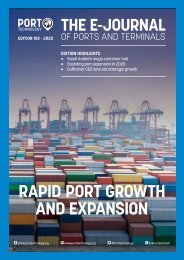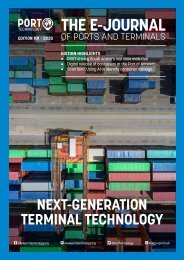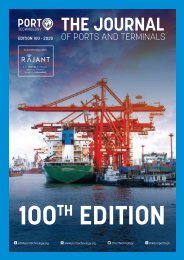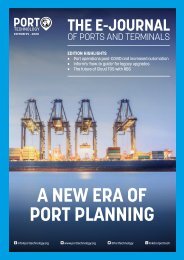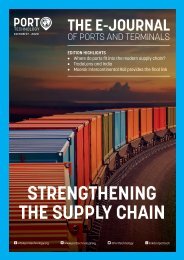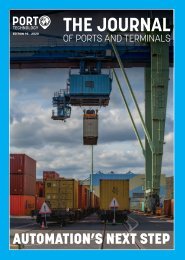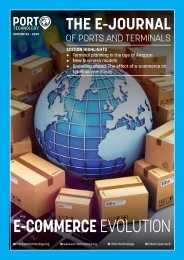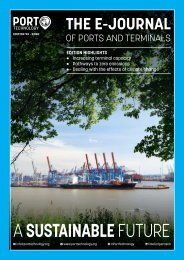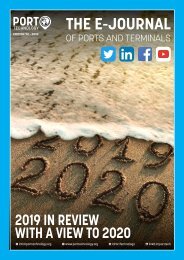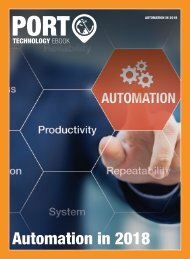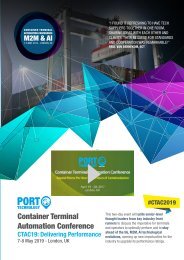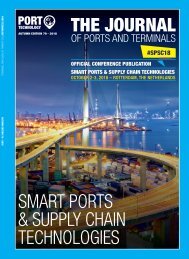Automation Innovations
As we enter the second half of 2020 the full effects of the COVID-19 pandemic are now being realised across the global economy and the port industry. For many, cargo throughput has been significantly decreasing compared with the same period for 2019. For example, the Port of Los Angeles handled 581,665 TEUs in May, a 29.8
As we enter the second half of 2020 the full effects of the COVID-19 pandemic are now being realised across the global economy and the port industry. For many, cargo throughput has been significantly decreasing compared with the same period for 2019.
For example, the Port of Los Angeles handled 581,665 TEUs in May, a 29.8
You also want an ePaper? Increase the reach of your titles
YUMPU automatically turns print PDFs into web optimized ePapers that Google loves.
Q&A WITH<br />
KALMAR AUTOMATION SOLUTIONS<br />
ABOUT THE AUTHORS<br />
Timo Alho has worked at Cargotec<br />
for 20 years, first in automation R&D,<br />
where his key project was the development<br />
of the Kalmar AutoStrad solution.<br />
During the past eight years, he<br />
has held various positions in terminal<br />
automation, from product management<br />
to the head of the cranes business<br />
line. He has been involved in all<br />
Kalmar terminal automation projects.<br />
Jarno Kuipers is a container terminal<br />
automation professional with more<br />
than 15 years’ experience in port automation.<br />
His background is in IT consultancy<br />
and in terminal operations<br />
management of a fully automated terminal,<br />
where he was involved heavily<br />
in the implementation of new technology.<br />
Before joining the Terminal Design<br />
Services team, Jarno held several<br />
positions involving sales and execution<br />
of terminal automation projects.<br />
Christopher Saavedra is a container<br />
terminal automation professional with<br />
more than seven years’ experience<br />
in port management and operations.<br />
His background is in military naval<br />
sciences and in terminal operations<br />
management of conventional and<br />
automated terminals, where he was<br />
heavily involved in the implementation<br />
and testing of new technologies.<br />
In his previous position at Kalmar, he<br />
led process improvement and optimization,<br />
connecting processes with<br />
staff, IT, customs and customers.<br />
ABOUT THE ORGANIZATION<br />
Kalmar, part of Cargotec, offers the widest<br />
range of cargo handling solutions and<br />
services to ports, terminals, distribution<br />
centres and to heavy industry. Kalmar is<br />
the industry forerunner in terminal automation<br />
and in energy efficient container<br />
handling, with one in four container<br />
movements around the globe being<br />
handled by a Kalmar solution. Through<br />
its extensive product portfolio, global<br />
service network and ability to enable a<br />
seamless integration of different terminal<br />
processes, Kalmar improves the efficiency<br />
of every move.<br />
WHAT BIG INNOVATIONS WILL IMPROVE<br />
THE ADOPTION OF AUTOMATION?<br />
The most important thing is to focus on the<br />
end user. The key to high productivity will<br />
not be better optimization algorithms, but<br />
helping end users get the most out of the<br />
system. Simpler systems with more efficient<br />
processes will let operators focus and<br />
keep the terminal performing in various<br />
operational situations, and quickly take the<br />
right actions. This is only possible if suppliers<br />
and end users collaborate well, towards<br />
a common goal.<br />
We also expect to see a different type of<br />
relation between terminal operators and<br />
automation suppliers that will be better<br />
suited for automation projects. We are already<br />
seeing new and innovative procurement<br />
strategies in various terminal automation<br />
projects, which all share an emphasis<br />
on value creation and risk reduction.<br />
One example is the performance-based<br />
contracting model, where the supplierbuyer<br />
relationship changes from a transactional<br />
one to a business partnership. The<br />
business partnership enables the terminal<br />
operator to perform better and the operator<br />
to focus on the terminal’s customers,<br />
ensuring maximum value for all. Many other<br />
industries have already made this type of<br />
shift successfully, so we should try to learn<br />
from them.<br />
WHY DOES THE RELATIONSHIP BETWEEN<br />
SUPPLIER AND OPERATOR NEED TO CHANGE<br />
AS WE MOVE FORWARD WITH AUTOMATION?<br />
As the automation system becomes the core<br />
part of the terminal’s operations, it is necessary<br />
to rethink how it can be continuously<br />
improved. Here, operator and supplier share<br />
a goal - the operator wants high productivity<br />
and consistency, both of which need a<br />
skilled and adequately resourced team. The<br />
supplier wants a high-performing reference<br />
case and satisfied customers. To do so, the<br />
current transactional model needs to evolve<br />
into a partnership, where both parties can<br />
excel in their area and reach the mutual goal.<br />
The current equipment procurement<br />
model restricts opportunities to evaluate<br />
the potential value of a long-term strategic<br />
partnership. If a terminal can provide value<br />
six months earlier and the initial productivity<br />
ramp-up can be made faster, it can create substantially<br />
more value than the savings gained<br />
through a traditional procurement process.<br />
ENQUIRIES<br />
www.kalmarglobal.com<br />
kalmar@kalmarglobal.com<br />
EDITION 98 25




